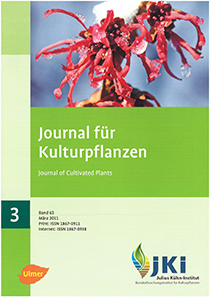Modelling of population dynamics of the Western Corn Rootworm (<em>Diabrotica virgifera virgifera</em>) – examination of various containment measures
DOI:
https://doi.org/10.5073/JfK.2011.03.02Keywords:
Diabrotica virgifera virgifera, Western corn rootworm, containment measures, pest control, efficacy, crop rotationAbstract
The population development of Western corn rootworm was calculated for a period of 9 years to examine various containment measures. The model takes account of various management measures. It uses a mean oviposition of 486 eggs per female and mean mortality from the egg to the adult of 97%. Without any control this results in a growth rate of 7.505 per generation. Application of control measures within a year reduces densities by the corresponding efficacy of the measure.
The model calculation shows that 75% of maize and more in crop rotation cause a rapid increase in population density. In this case insecticide seed dressing or soil granules are not sufficient to prevent a rapid increase in population density. The model shows that the control of adults leads to a decrease of the density. Since, however, efficiency is heavily dependent on weather and environmental conditions this measure is not suitable for containment on a large area. 66% of maize in crop rotation causes only a slight increase in density which could be compensated within several years when weather conditions are unfavourable. A combination of 66% of maize in crop rotation and insecticide application at least in first-year maize causes a reduction in population density. Furthermore, the model shows that a maximum of 50% of maize in rotation reduces Western corn rootworm density also without insecticide use.
Calculations recommend the following measures for containment: 66% of maize in rotation combined with insecticide application in first-year maize, or a maximum of 50% of maize in rotation. 66% of maize in rotation can only be recommended in combination with continuous monitoring and additional measures in case of increasing densities. Containment of Western corn rootworm is not achieved when maize exceeds 66% in rotation or only insecticide treatment is applied.
Downloads
Published
Issue
Section
License
The content of the journal is licensed under the Creative Commons Attribution 4.0 License. Any user is free to share and adapt (remix, transform, build upon) the content as long as the original publication is attributed (authors, title, year, journal, issue, pages).
The copyright of the published work remains with the authors. The authors grant the Journal of Cultivated Plants, the Julius Kühn-Institut and the OpenAgrar repository the non-exclusive right to distribute and exploit the work.







